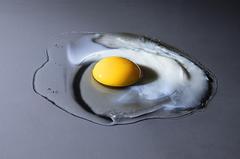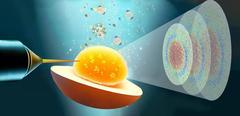URL: https://www.desy.de/news/news_search/index_eng.html
Breadcrumb Navigation
DESY News: Cooking eggs for science
News
News from the DESY research centre
Cooking eggs for science
A group of researchers has used DESY’s brilliant X-ray source PETRA III to analyse the structural changes that take place in egg yolk when you cook it. The work shows how different constituents in the yolk of a chicken egg contribute to the development of the soft-grainy microstructure of egg yolk which one receives when it is heated. This may not only be of interest to the food industry but may also serve as a model for the physics behind biologically relevant non-equilibrium processes such as protein aggregation which are connected to a number of severe diseases. The team of researchers from University of Siegen, Tübingen University, DESY and TU Dortmund now report new insights into these processes in the journal Nature Communications.

At PETRA III, a research team has studied what happens to the structure of egg yolks when they are heated. Photo: DESY, Gesine Born
Apart from its food, biological, and also therapeutic value the diversity of proteins and high concentration of LDLs make egg yolk also an ideal candidate for studying the physics behind biologically relevant non-equilibrium processes. Most often denaturation and aggregation of proteins and LDLs are undesirable in biological systems, especially in relation to the pathogenesis of several human diseases such as Alzheimer’s disease, Parkinson’s disease, atherosclerosis, and others. Furthermore, the instability and aggregation of protein drugs, caused by deviations from optimal conditions of temperature, pH, ionic strength, etc. are one of the main challenges the pharmaceutical industry faces.

Illustration of the study: Using X-ray photon correlation spectroscopy, the researchers found out how the components in the yolk of a chicken egg contribute to the development of its soft-grained microstructure when heated. Graphic: University of Siegen, Marie Abhag Lousie
From their large data sets the team could construct even a generic time-temperature phase diagram for the out-of-equilibrium processes during egg yolk gelation. “This diagram is impressive as it nicely illustrates the coupling of the nanoscale processes that give rise to the gel structure in a wide range of time-temperature combinations,“ says Nafisa Begam (Tübingen University) from the researcher´s team.
“These experiments make ideal use of the coherent fraction of the X-ray radiation produced at PETRA III,” notes Fabian Westermeier, member of the P10 team at PETRA III. “However, this fraction is limited. The coherent part of the beam at DESY’s future project PETRA IV will be a hundred times larger, enabling up to 10000-times better time resolution for measuring and understanding these processes.”
Christian Gutt points out that the results of the studies financed by the federal ministry BMBF are based on a close collaboration between DESY and the University teams and explains: “We expect our results to be relevant beyond egg yolk and that similar scaling laws will accompany a large range of denaturation phenomena and nanoscale structure formation in biologically significant dense protein systems.”
Future research from this collaboration will explore the aggregation of egg yolk proteins caused by deviations from optimal conditions of salt and pH. This could provide insights on the suitable conditions for stabilizing the proteins, which has implications for storage conditions of future protein-based drugs.
Reference
Exploring non-equilibrium processes and spatio-temporal scaling laws in heated egg yolk using coherent X-rays: Nimmi Das Anthuparambil et al.; Nature Communications, 2023, DOI: 10.1038/s41467-023-41202-z



